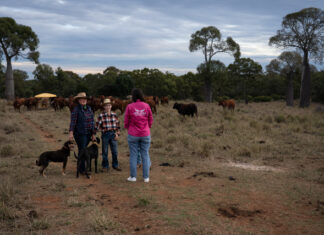Australian farm production is soaring towards a new record value of $90 billion for 2022-23, smashing expectations.
But, the fun times may be fleeting.
Escalating export competition, drier seasons and tighter global economic times are predicted to shrink farmgate earnings.
The value of agricultural production is expected to fall to $81b next financial year, having jumped to within $10b of the farm sector’s oft-discussed $100b target for 2030.
And, according to the Australian Bureau of Agricultural Resource Economics and Science (ABARES), it may slip to between $73b and $79b in the following four years.
Production values remain $20b higher than the national commodities forecaster suggested for 2017, 2018 and 2019.
But, they warn farmers that drought-like weather, persistent inflationary pressures and higher global interest rates are assumed over the coming years.
ABARES, however, is also tipping big grain and oilseed crops and record volumes of wheat, barley, canola, cotton and sorghum exports to fuel farm exports to $75b this financial year.
Despite high shipping freight costs, export activity and returns have spurred high global commodity demand and prices that remain near last year’s 30-year highs.
And, Australia was reaping the benefits of a third consecutive year of high rainfall, said ABARES executive director Dr Jared Greenville.
*** Biggest ever winter crop
While flooding and waterlogging in parts of eastern Australia disrupted harvest and saw localised crop and livestock losses, exceptional conditions in most cropping areas would deliver the nation’s biggest ever winter grain crop.
“It shows in the figures,“ Dr Greenville said.
“We’ve seen record levels of production driven by exceptional growing conditions and high commodity prices.
“The winter crop is estimated at a new record of 67.3 million tonnes in 2022-23, beating last year’s record by 4m tonnes.“
Western Australia and South Australia had made up for the eastern states setbacks to produce exceptional yields, resulting in new records for wheat and canola and probably the third largest barley harvest on record.
“High values of livestock production also contributed to these record numbers, with producers increasing their output while also benefiting from historically high prices,“ Dr Greenville said.
Leaner years ahead
ABARES, however, is bracing for drier, leaner times ahead.
It warns the prospect of El Nino weather patterns replacing the past three years’ La Nina conditions could create productivity and balance sheet pressures for producers.
As such, the area planted to irrigation crops, grapes and cotton may shrink by a third by 2027-28 as a drying scenario accelerated adjustment across the farm sector, pressuring lesser productive enterprises to consolidate.
ABARES calculated the impact of drier conditions and macroeconomic pressures on global demand could cut the value of Australian agricultural production by as much as $37b over the next five years.
In the coming financial year alone the value of crop output was tipped to fall about $8b, to $46b.
The winter crop is expected to lose about 30pc of its worth; livestock output was expected plateau at about $35b and horticulture could increase by $2b in value to a record $18.2b.
While good soil moisture conditions and high water storage levels would continue to support production – and the past three years had created a buffer that helped farmers recover from the last drought – Dr Greenville said the shift to a drier climate sequence, combined with global economic uncertainty continuing for longer, would put greater pressure on farm sector growth.
“Recent high international prices have been driven by drought conditions in major exporters and disruptions from the war in Ukraine,“ he said.
“But seasonal conditions are expected to improve in major overseas producing regions, which will see major exporters getting back on track in 2023-24.
“Over the medium term to 2027-28, seasonal conditions are expected to return to a more normal sequence and commodity prices are expected to fall.“
Financial risks
He said many farmers would be well positioned to ride through the domestic and international changes, but ABARES predicted the financial positions and investment behaviour of those remaining in the industry was likely to be affected by the changing risks ahead.
Investment in future production or productive capital would be curbed.
Farmers would be less able to take on debt because lower farm returns were expected.
Producers could also choose to forego planting crops or increase livestock numbers to minimise farm costs.
Key points
* Value of agricultural production to reach a record $90 billion in 2022/23.
* Value of exports to a reach a record $75b in 2022/23.
* Production and export values to fall in 2023/24, to reach $81b and $64b, respectively.
* A return to drier conditions in 2023/24 to drive falls in production, particularly for crops.
* International commodity prices forecast to ease as global production of key commodities recovers.







